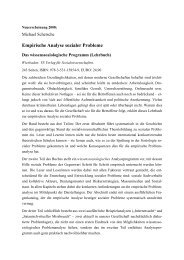Psychophysiology of False Memories in a Deese-Roediger ... - IGPP
Psychophysiology of False Memories in a Deese-Roediger ... - IGPP
Psychophysiology of False Memories in a Deese-Roediger ... - IGPP
You also want an ePaper? Increase the reach of your titles
YUMPU automatically turns print PDFs into web optimized ePapers that Google loves.
<strong>Psychophysiology</strong> <strong>of</strong> Visual <strong>False</strong> <strong>Memories</strong><br />
condition: 50%), but still substantial. As expected, the proportion<br />
<strong>of</strong> false recognition <strong>of</strong> related lures was dist<strong>in</strong>ctly higher than the<br />
proportion <strong>of</strong> falsely recognized unrelated items. This result<br />
pattern is typical for DRM studies and po<strong>in</strong>ts out that comb<strong>in</strong><strong>in</strong>g<br />
visual scenes <strong>in</strong> the study phase with pictorial stimuli <strong>in</strong> the<br />
recognition phase yields behavioral results comparable to previous<br />
DRM studies.<br />
Differences between the true recognition rates for related<br />
controls and studied items <strong>in</strong> the control group po<strong>in</strong>t to systematic<br />
a priori differences <strong>of</strong> these stimulus types. These are a<br />
consequence <strong>of</strong> the use <strong>of</strong> a ‘‘classical’’ DRM design because<br />
there, related lures are chosen <strong>in</strong> terms <strong>of</strong> their forward and<br />
backward associative strength [64] and not <strong>in</strong> terms <strong>of</strong> be<strong>in</strong>g<br />
comparable to studied items. The present study featured betweengroup<br />
analyses <strong>of</strong> psychophysiological measures to control for this<br />
bias statistically. Regrettably, no comparisons with previous studies<br />
are possible, because ‘‘classical’’ DRM design studies have not<br />
reported control group data. Additionally, the direction <strong>of</strong> this bias<br />
po<strong>in</strong>ts to lower memorability <strong>of</strong> lures. Know<strong>in</strong>g this direction is<br />
important, s<strong>in</strong>ce it <strong>in</strong>dicates that the false memory rate <strong>in</strong> the<br />
experimental group is robust and not due to this bias. On the<br />
contrary, the false memory rate would have supposedly been<br />
higher without this bias.<br />
Physiological measures<br />
Psychophysiological results showed a significant between-group<br />
<strong>in</strong>teraction for EDA. Though respiration l<strong>in</strong>e length and phasic<br />
heart rate tendentially differed between false and true recognition<br />
with<strong>in</strong> the experimental group, the f<strong>in</strong>d<strong>in</strong>gs for these measures<br />
need to be <strong>in</strong>terpreted with care, s<strong>in</strong>ce only between-group<br />
<strong>in</strong>teractions address a-priori stimulus differences. No effects were<br />
found for f<strong>in</strong>ger pulse waveform length. The reason for this<br />
rema<strong>in</strong>s unclear; a visual <strong>in</strong>spection suggests that it might be due<br />
to <strong>in</strong>sufficient f<strong>in</strong>ger pulse waveform length signal quality <strong>in</strong> a<br />
considerable number <strong>of</strong> participants.<br />
The lack <strong>of</strong> significant between-group f<strong>in</strong>d<strong>in</strong>gs for respiration<br />
l<strong>in</strong>e length, phasic heart rate, and f<strong>in</strong>ger pulse waveform length<br />
might have several reasons: Firstly, it might be due to the relatively<br />
small number <strong>of</strong> falsely recognized related lures. In CIT studies,<br />
the number <strong>of</strong> items to be <strong>in</strong>cluded <strong>in</strong> the analysis is foreseeable<br />
and does not differ greatly between subjects. Yet, this is not the<br />
case <strong>in</strong> DRM studies. Thus, <strong>in</strong> DRM studies, data represent<strong>in</strong>g<br />
physiological with<strong>in</strong>-subject differences <strong>of</strong> some participants tend<br />
to be quite noisy. Regard<strong>in</strong>g the CIT, meta-analytic evidence<br />
shows that the number <strong>of</strong> questions (and thus, the number <strong>of</strong><br />
‘‘probe’’ items) is positively related to effect size [1]. Secondly, the<br />
Prelim<strong>in</strong>ary Process Theory predicts that EDA should be most<br />
closely related to orient<strong>in</strong>g sub-processes sensitive to stimulus<br />
significance. Furthermore, <strong>in</strong> CIT studies, EDA is consistently the<br />
marker with the largest effect sizes [1].<br />
In sum, the relatively small number <strong>of</strong> falsely recognized related<br />
lures might have caused a generally small physiological effect,<br />
which was suprathreshold <strong>in</strong> EDA only, because EDA is most<br />
closely related to significance and the strongest marker <strong>in</strong> CIT<br />
studies. In this sense, the study might have been underpowered<br />
with respect to cardiovascular and respiratory measures.<br />
The analysis <strong>of</strong> sk<strong>in</strong> conductance responses showed greater<br />
response amplitudes associated with true than false recognition.<br />
This can be viewed <strong>in</strong> the light <strong>of</strong> the observation from CIT<br />
studies that familiar objects evoke stronger orient<strong>in</strong>g reactions and<br />
therefore greater sk<strong>in</strong> conductance responses than unknown<br />
objects.<br />
The present EDA result could be <strong>in</strong>terpreted accord<strong>in</strong>g to the<br />
Prelim<strong>in</strong>ary Process Theory. The Prelim<strong>in</strong>ary Process Theory [34]<br />
states that orient<strong>in</strong>g is modulated by significance, which can be a<br />
product <strong>of</strong> classical condition<strong>in</strong>g (through cortical sets). The study<br />
phase was presumably associated with additional focused cortical<br />
activity (cortical sets; e.g. because <strong>of</strong> the <strong>in</strong>struction or schematic<br />
knowledge). The studied items (be<strong>in</strong>g paired with the cortical sets)<br />
acquired significance through classical condition<strong>in</strong>g. In the<br />
recognition phase, the studied items (now conditioned stimuli)<br />
elicited significance as conditioned response, which <strong>in</strong> turn<br />
modulated the orient<strong>in</strong>g reflex. The heightened orient<strong>in</strong>g response<br />
was thus reflected <strong>in</strong> greater EDA responses.<br />
The f<strong>in</strong>d<strong>in</strong>g <strong>of</strong> the present study could cautiously be <strong>in</strong>terpreted<br />
<strong>in</strong> that CIT-like differentiations <strong>of</strong> known and unknown objects<br />
are possible, even if a subject is unaware <strong>of</strong> actually not know<strong>in</strong>g<br />
some <strong>of</strong> the objects. Possibly, differentiation <strong>of</strong> true and false<br />
recognition by means <strong>of</strong> sk<strong>in</strong> conductance might be more<br />
attributable to the objective knowledge <strong>of</strong> an object and less to<br />
the subjective belief <strong>of</strong> know<strong>in</strong>g it. Early EDA studies [65,66]<br />
co<strong>in</strong><strong>in</strong>g the phrase ‘‘subception’’ have brought forward evidence<br />
that implicit knowledge is accompanied by greater EDA responses<br />
than lack<strong>in</strong>g knowledge. This is <strong>in</strong> l<strong>in</strong>e with the physiological<br />
discrim<strong>in</strong>ation <strong>of</strong> known vs. unknown faces <strong>in</strong> prosopagnosic<br />
patients (e.g. [67–69]). For a discussion <strong>of</strong> the applicability <strong>of</strong> the<br />
CIT <strong>in</strong> the cl<strong>in</strong>ical context and conceptual considerations about<br />
implicit knowledge, explicit knowledge and prosopagnosia, see<br />
[70].<br />
Conclusions<br />
The present study <strong>in</strong>troduced two <strong>in</strong>novations. Firstly, it<br />
comb<strong>in</strong>ed a modified DRM paradigm with record<strong>in</strong>gs <strong>of</strong> several<br />
measures <strong>of</strong> peripheral physiology. This was ma<strong>in</strong>ly carried out by<br />
borrow<strong>in</strong>g methodological and theoretical concepts from the CIT<br />
paradigm. Still, it is unclear, which CIT-processes can be<br />
transferred to false memory research. In the detection <strong>of</strong> concealed<br />
<strong>in</strong>formation, the orient<strong>in</strong>g reflex and its modulators significance and<br />
novelty [29] are seen as primarily responsible for the effects reported<br />
<strong>in</strong> CIT studies [40].<br />
It is plausible to assume that true recognition <strong>of</strong> studied items <strong>in</strong><br />
DRM studies and true recognition <strong>of</strong> probe items <strong>in</strong> CIT studies<br />
are both associated with heightened significance. Gati and Ben-<br />
Shakhar [38] attempted to clarify the roles <strong>of</strong> significance and<br />
novelty <strong>in</strong> the orient<strong>in</strong>g reflex by a series <strong>of</strong> CIT experiments.<br />
They stated that ‘‘responsivity is positively related to the degree <strong>of</strong><br />
match between the <strong>in</strong>put and the representation <strong>of</strong> significance’’.<br />
A speculative explanation for false recognition be<strong>in</strong>g accompanied<br />
by smaller EDA responses than true recognition could be that false<br />
recognition is accompanied by a higher mismatch between <strong>in</strong>put<br />
and the representation.<br />
In other words, a subject ga<strong>in</strong>s (mental) representations <strong>of</strong> the<br />
related lures dur<strong>in</strong>g the study phase. This process is supposedly<br />
<strong>in</strong>fluenced by schematic knowledge. The representations match<br />
poorly to the actual stimuli shown <strong>in</strong> the recognition phase, while<br />
the representations <strong>of</strong> studied items match relatively well to the<br />
(same) stimuli shown <strong>in</strong> the recognition phase. If this is the case,<br />
the lack <strong>of</strong> significance <strong>of</strong> falsely recognized related lures would be<br />
a suitable explanation for our result.<br />
As a second <strong>in</strong>novation, this study has been conducted with a<br />
study phase with visual scenes and a pictorial recognition phase,<br />
ensur<strong>in</strong>g comparable modalities for the encod<strong>in</strong>g and the retrieval<br />
phase. We argue that this is an important feature <strong>of</strong> a visual DRM<br />
study, s<strong>in</strong>ce modalities should be equal to speak <strong>of</strong> recognition <strong>in</strong><br />
the literal sense. Equality <strong>of</strong> modalities might be <strong>in</strong>terpreted as one<br />
<strong>of</strong> <strong>Roediger</strong> and McDermott’s [2] crucial changes <strong>of</strong> <strong>Deese</strong>’s [71]<br />
paradigm.<br />
PLoS ONE | www.plosone.org 7 January 2012 | Volume 7 | Issue 1 | e30416


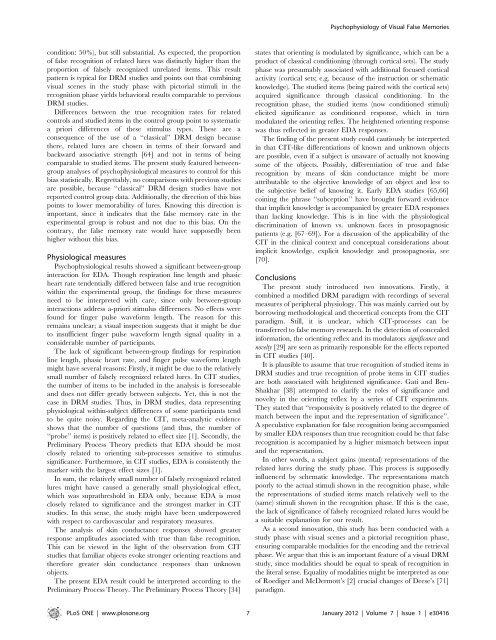
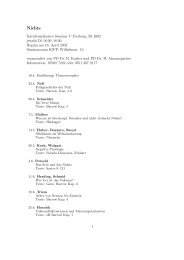
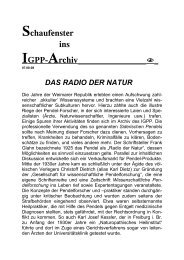
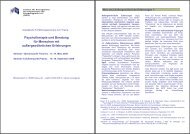
![Findliste Nachträge1 [pdf] - IGPP](https://img.yumpu.com/22552359/1/184x260/findliste-nachtrage1-pdf-igpp.jpg?quality=85)

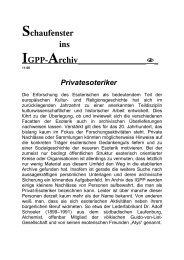
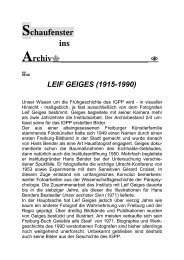
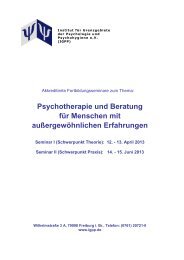
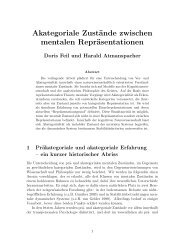
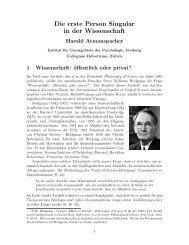
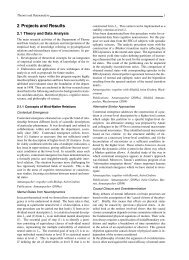
![Findliste [pdf] - IGPP](https://img.yumpu.com/22552265/1/190x245/findliste-pdf-igpp.jpg?quality=85)

